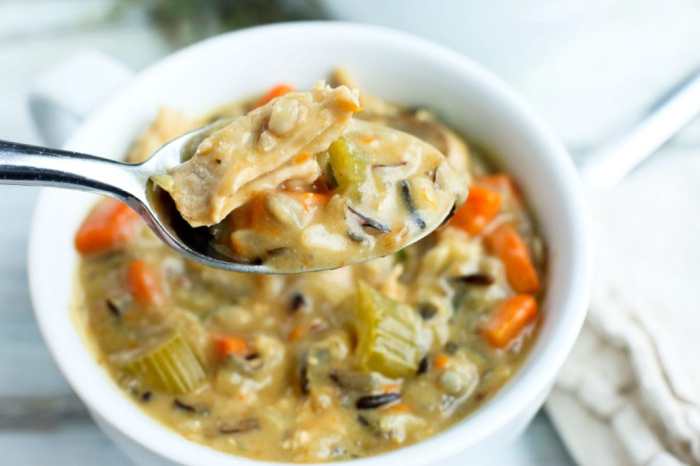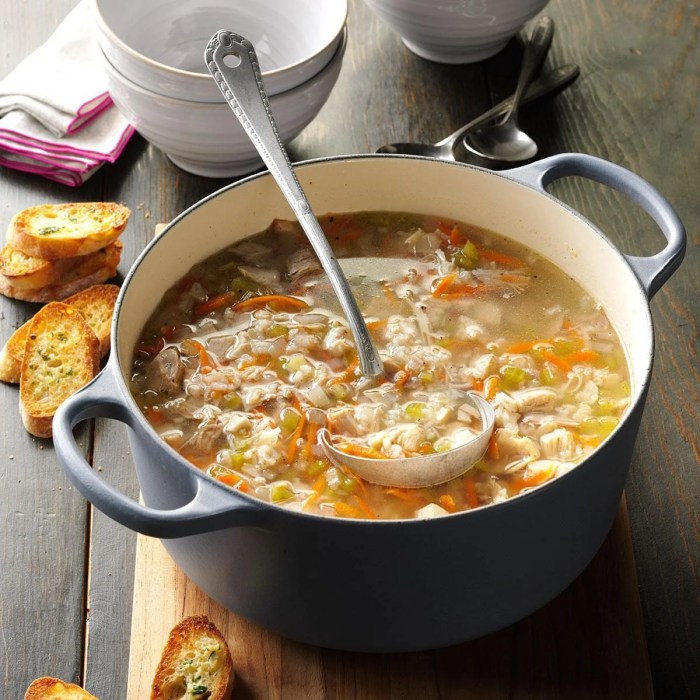Homemade Turkey Soup: A Comforting Classic
Recipe for homemade turkey soup – Homemade turkey soup offers a comforting warmth and satisfying flavor that transcends simple sustenance. Its versatility allows for endless customization, catering to diverse palates and dietary needs. Beyond its deliciousness, turkey soup provides numerous health benefits, making it a nourishing and enjoyable meal. This hearty dish boasts a rich history, woven into the fabric of various cultures, symbolizing both celebration and comfort.
Health Benefits and Cultural Significance of Turkey Soup

Source: happyhealthymama.com
Turkey soup is a nutritional powerhouse. Turkey meat is a lean protein source, rich in essential amino acids. The vegetables commonly included – carrots, celery, onions, and potatoes – provide vitamins, minerals, and fiber. The broth itself, especially if homemade, offers electrolytes and hydration. Historically, turkey soup has held a prominent place in various cultures, often served during holidays and celebrations or as a restorative remedy during illness.
In many traditions, it represents nourishment and togetherness.
Essential Ingredients and Preparation
Creating a delicious turkey soup begins with selecting high-quality ingredients. Proper preparation ensures optimal flavor and texture. This section details the key components and their preparation.
Essential ingredients typically include: leftover roasted or poached turkey (or raw turkey breast), high-quality chicken or turkey broth, carrots, celery, onions, potatoes, herbs (such as thyme, rosemary, or sage), and seasonings (salt, pepper, etc.).
Using high-quality broth forms the foundation of a flavorful soup. Homemade broth, simmered with bones and aromatics, provides a superior depth of flavor compared to store-bought options. The turkey can be prepared in various ways; leftover roasted turkey offers convenience, while poaching a turkey breast yields tender, easily shredded meat. Fresh vegetables and herbs contribute significantly to the soup’s taste and nutritional value.
Choose firm, vibrant vegetables free from blemishes.
| Vegetable | Flavor Profile | Nutritional Value | Notes |
|---|---|---|---|
| Carrots | Sweet, earthy | Rich in beta-carotene (Vitamin A) | Adds sweetness and color |
| Celery | Slightly bitter, aromatic | Good source of Vitamin K and fiber | Provides a savory base |
| Onions | Sharp, pungent (mildens with cooking) | Contains antioxidants and fiber | Adds depth of flavor |
| Potatoes | Starchy, mild | Good source of potassium and Vitamin C | Provides creaminess and heartiness |
Step-by-Step Soup Making Process, Recipe for homemade turkey soup
The process of making turkey soup involves several key steps to ensure a flavorful and well-balanced result. Proper simmering techniques and thickening methods are crucial for achieving optimal consistency and texture.
- Sauté Aromatics: Sauté diced onions, carrots, and celery in a large pot until softened.
- Add Turkey and Broth: Add the turkey (cooked or raw), broth, herbs, and seasonings. Bring to a boil, then reduce heat and simmer.
- Simmer: Simmer for at least 30 minutes, or longer for deeper flavor. The longer it simmers, the more the flavors meld.
- Add Potatoes: Add diced potatoes and continue to simmer until tender (about 15-20 minutes).
- Thicken (Optional): If desired, thicken the soup with a roux (butter and flour mixture) or a cornstarch slurry.
- Season and Serve: Taste and adjust seasoning as needed. Serve hot.
Variations and Flavor Enhancements
The beauty of turkey soup lies in its adaptability. This section explores various flavor profiles and ingredient additions to enhance the classic recipe.
- Creamy Turkey Soup: Stir in heavy cream or coconut milk for a richer texture.
- Spicy Turkey Soup: Add a pinch of cayenne pepper, a dash of hot sauce, or some chopped jalapeños for a spicy kick.
- Turkey Noodle Soup: Add egg noodles or other pasta during the last 10-15 minutes of cooking.
Experiment with different herbs and spices such as parsley, dill, bay leaf, or even a touch of curry powder. Adjust seasoning according to your preference. Consider adding other vegetables like parsnips, turnips, or green beans for variety.
- Flavor Pairings:
- Thyme and Rosemary
- Sage and Onion
- Parsley and Lemon
- Celery and Black Pepper
Serving and Storage Suggestions
Proper serving and storage techniques ensure the longevity and enjoyment of your homemade turkey soup. Presentation also enhances the dining experience.
Serve the soup hot, ideally in warmed bowls. Accompany it with crusty bread, crackers, or a side salad. Leftover soup can be stored in airtight containers in the refrigerator for up to 3-4 days or frozen for up to 2-3 months.
For an appealing presentation, consider garnishing the soup with fresh herbs (such as parsley or chives), a swirl of cream, or a sprinkle of freshly cracked black pepper. Serve in attractive bowls and use a coordinating place setting for an elevated dining experience.
An image of the soup would show a steaming bowl filled with a golden broth, flecked with the vibrant colors of carrots, celery, and onions. Tender pieces of turkey would be visible, alongside soft potatoes. The overall texture would appear hearty and comforting, with a slight sheen from the broth.
Troubleshooting Common Issues

Source: tmbi.com
Even experienced cooks encounter occasional challenges when making soup. Understanding common problems and their solutions can prevent disappointment.
- Overly Salty Soup: Add a peeled and halved potato to absorb excess salt. Alternatively, add a splash of lemon juice or a dollop of plain yogurt to balance the saltiness.
- Bland Soup: Increase the amount of herbs, spices, or add a squeeze of lemon juice to brighten the flavor.
- Watery Soup: Simmer the soup uncovered for a longer period to reduce the liquid. Alternatively, thicken the soup with a roux or cornstarch slurry.
Adjusting the recipe based on personal preferences and available ingredients is key to creating a unique and satisfying bowl of turkey soup. Don’t be afraid to experiment with different combinations of vegetables, herbs, and spices to discover your own perfect recipe.
FAQ Insights: Recipe For Homemade Turkey Soup
Can I use frozen turkey?
Yes, completely thawed frozen turkey works well. Ensure it’s fully thawed before adding it to the soup.
How long can I store leftover soup?
Leftover soup can be stored in the refrigerator for up to 4 days and in the freezer for up to 3 months.
What if my soup is too salty?
Add a peeled and chopped potato to the soup; it will absorb some of the excess salt. You can also add a splash of milk or cream to help balance the saltiness.
A comforting homemade turkey soup recipe often involves using leftover turkey carcass for a rich broth. For those seeking similar flavorful options using different leftover meats, exploring prime rib leftover recipes soups might offer inspiration. Returning to turkey soup, remember to add your favorite vegetables for a hearty and delicious meal.
Can I make this soup in a slow cooker?
Yes, a slow cooker is a great option! Adjust cooking times accordingly, typically 6-8 hours on low or 3-4 hours on high.
